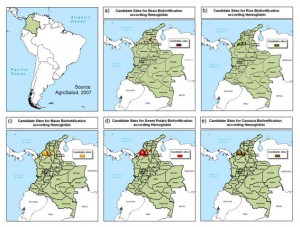Emmanuel Zapata Caldas, a geography student at the Universidad del Valle in Colombia, has won second prize at the XVIII National Geography Event for his work, carried out in collaboration with CIAT, on the spatial analysis of malnutrition in Latin America. Reproduced below are some of his results for Colombia, which he kindly made available to us (click to enlarge).
For this particular analysis, Emmanuel looked at the prevalence of anemia and used secondary data on poverty and agricultural production to identify sites in Colombia where the biofortification of different crops could have a significant impact on this aspect of malnutrition. Congratulations to Emmanuel for his prize, and his interesting work.

Congratulations indeed to Emanuel, and not to carp, but if the ultimate goal is to increase iron intake, is biofortification the best solution? Leaving aside questions of bioavailability, might it be better to change the diet in other ways, perhaps by adding more animal protein or some of the leafy greens that are rich in iron?
I understand that biofortification wasn’t the point of the exercise, but I do feel that it can sometimes be seen as the only solution to malnutrition, and it isn’t.
I guess the results of the work could be used to target any sort of nutrition intervention, biofortification or otherwise. But it would be interesting to hear what Emmanuel says.
Yes, I think this method can be used to target any sort of intervention. Biofortification is probably the easiest to target. Supplementation and food fortification would perhaps then be the next easiest to target. You would need to find the populations at risk. You would also need to know something about how the health system might support a supplementation intervention. For food fortification, you need to know something about how basic foods are processed and distributed in the country.
But how would you target a diet diversity intervention? The problem here is that the populations most at risk of micronutrient deficiency are the ones that cannot afford diverse diets. I don’t want to beat a dead horse either. But we cannot expect diet diversity to work, unless we do much more research and development in fruits and vegetables and other foods that contribute to micronutrient health. Something needs to be done to bring the prices of these foods down and within the reach of malnourished households.
Glenn, are you saying that the “malnourished households” are targeted to grow the proposed biofortified staples? Or that they will buy and eat the product? Because if they are to grow the staples, have the land and so forth, then dietary diversification is probably just as easy or difficult to implement.
Pido disculpas por escribir en castellano, pero es la única manera de exponer claramente lo que opino y de evitar mal interpretaciones.
Estoy de acuerdo con todo lo que se ha comentado, creo que las intervenciones de biofortificación deben ser vistas como un medio para el mejoramiento de la calidad de vida de los hogares malnutridos, pero también soy consciente de que existen otros caminos para alcanzar dicho objetivo (e.g. diversificación de dietas, suplementación, fortificación, entre otros). El gran logro de este análisis es que permitó identificar poblaciones que cuentan con las características ideales para ser el blanco de los programas de mejoramiento nutricional existentes en la región latinoaméricana y caribeña, aunque se encuentra vinculado con la biofortificación por razones académicas, irremediablemente los lugares propuestos son el resultado de un ejercicio espacial que incluyó variables agrícolas, nutricionales y socioeconómicas, y que no se limita al tipo de intervención a realizar, más bien a la confianza que depositen los tomadores de decisiones en enfocar sus esfuerzos en los lugares propuestos.
Like most things in life, this is not black and white. You need both. To the diversificists out there, I ask why noone diversifies their diets when there is all these vegetables and fruits out there, with seed available, or available in the markets? To the biofortificists, why go to so much trouble when you can increase vitamin intake by eating pumpkin, which is a weed in the tropics. Let’s face it – you need both. And you need to work on the market chains on both. Emmanuel’s analysis is great for targetting biofortification, and is badly needed. I’d say the biggest beneficiaries might also be in urban areas where access to fruit and vegetable is that little more difficult. But that i would imagine comes in a second phase when the supply chain issues for biofortified regions are figured out.
Both? How boring.
Hey, I’ve got the perfect solution!
At a seminar in Oslo today I learned about an even more perfect solution. Moringa -your pharmacy in the garden.